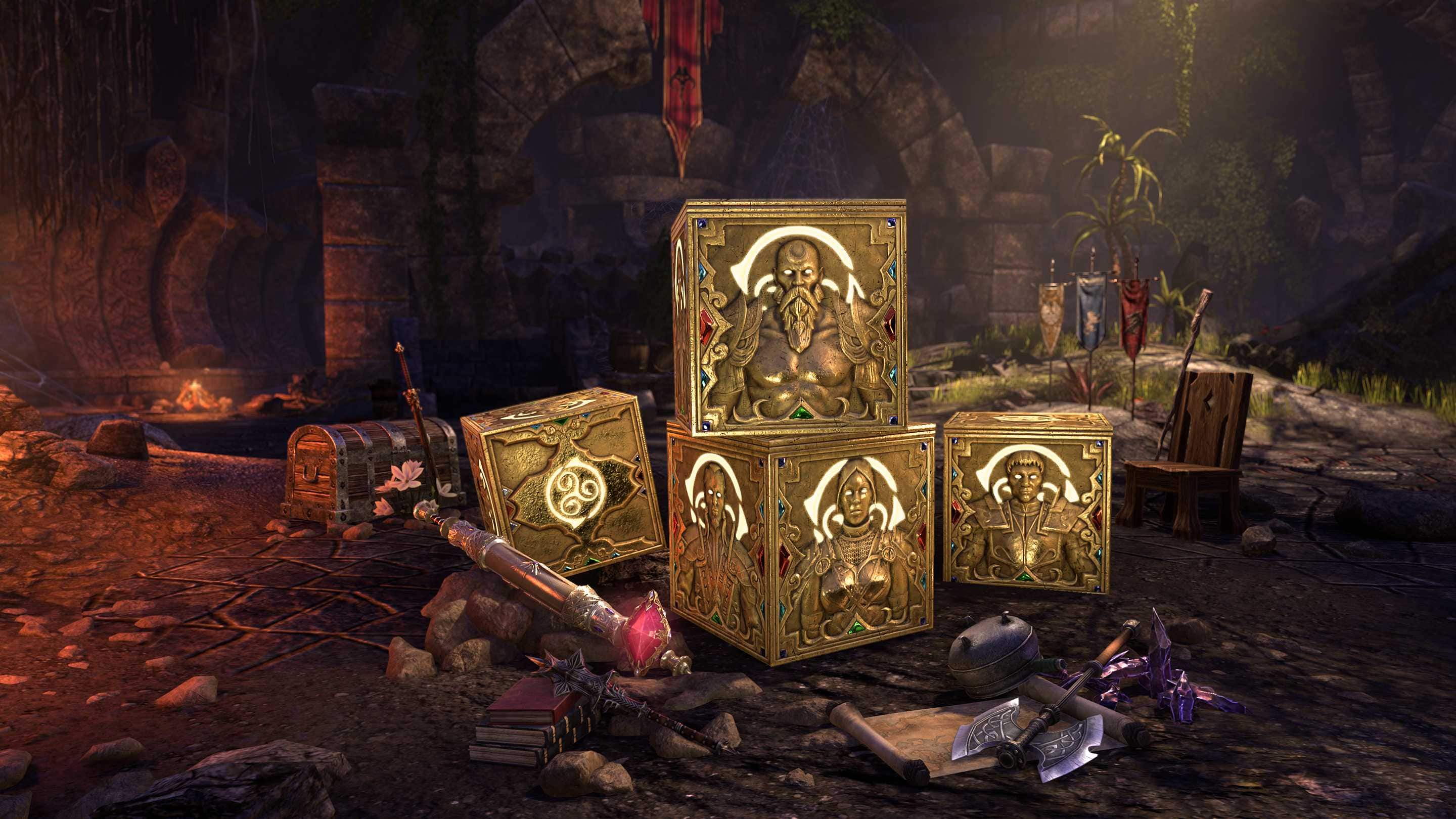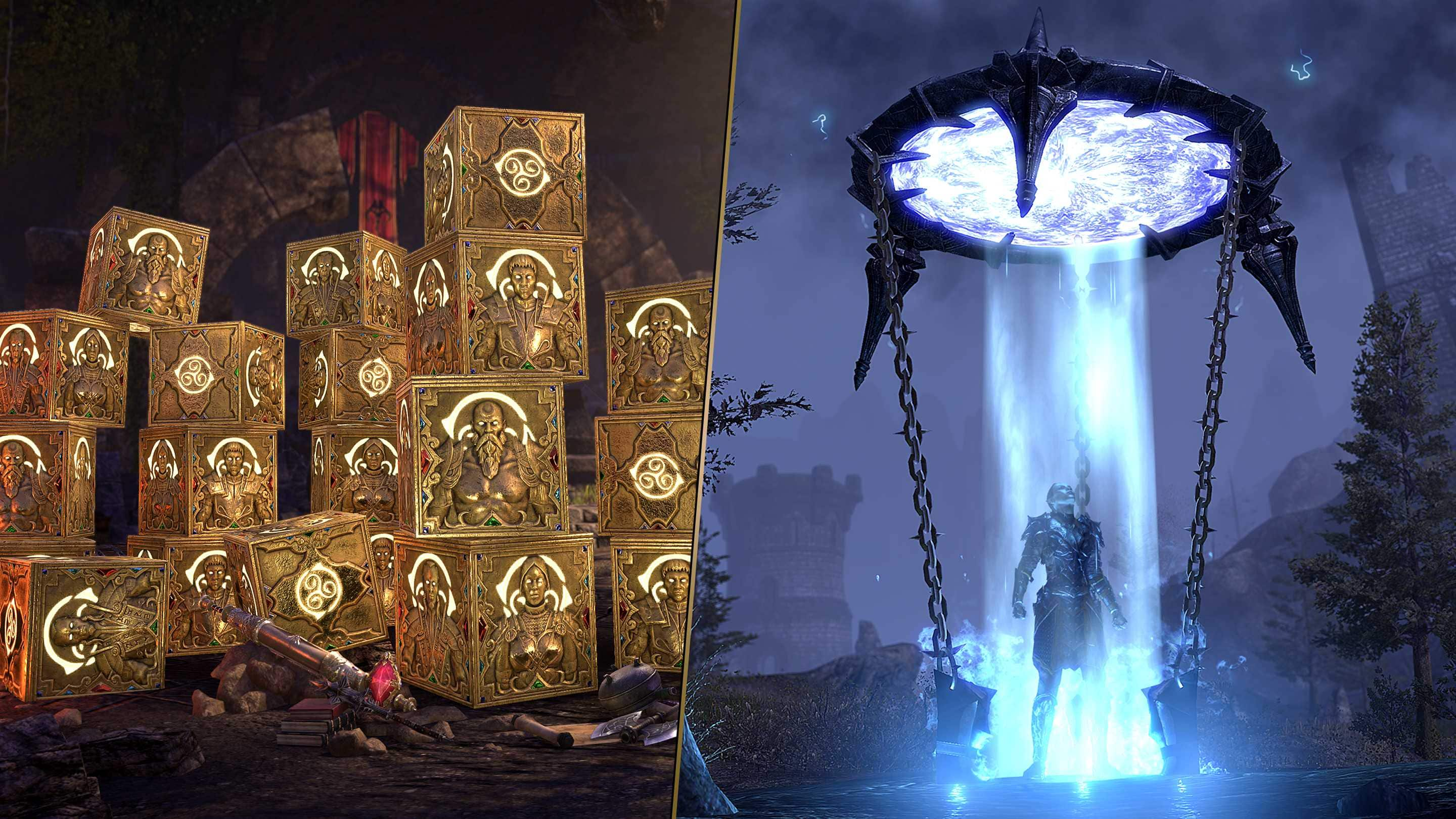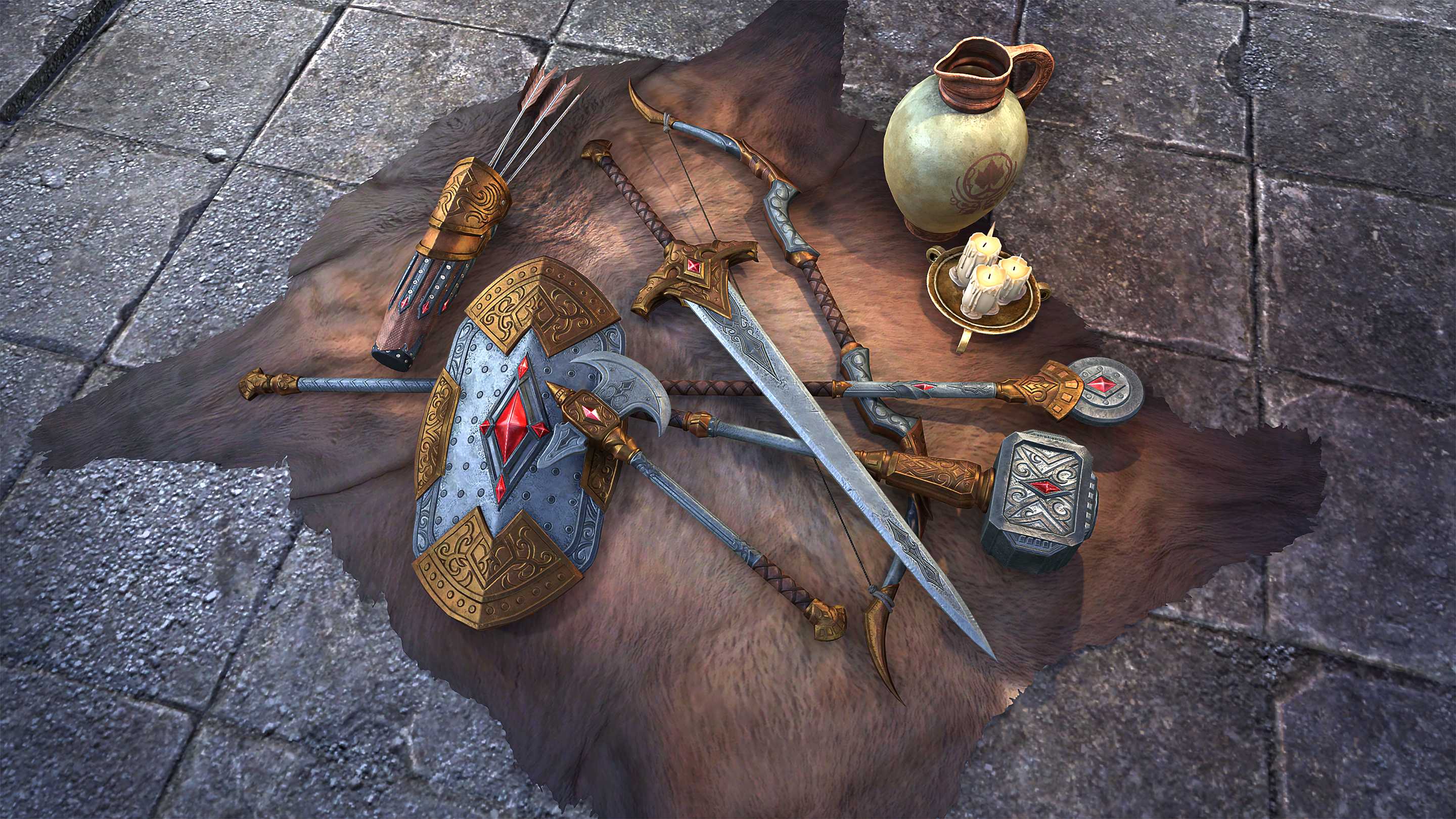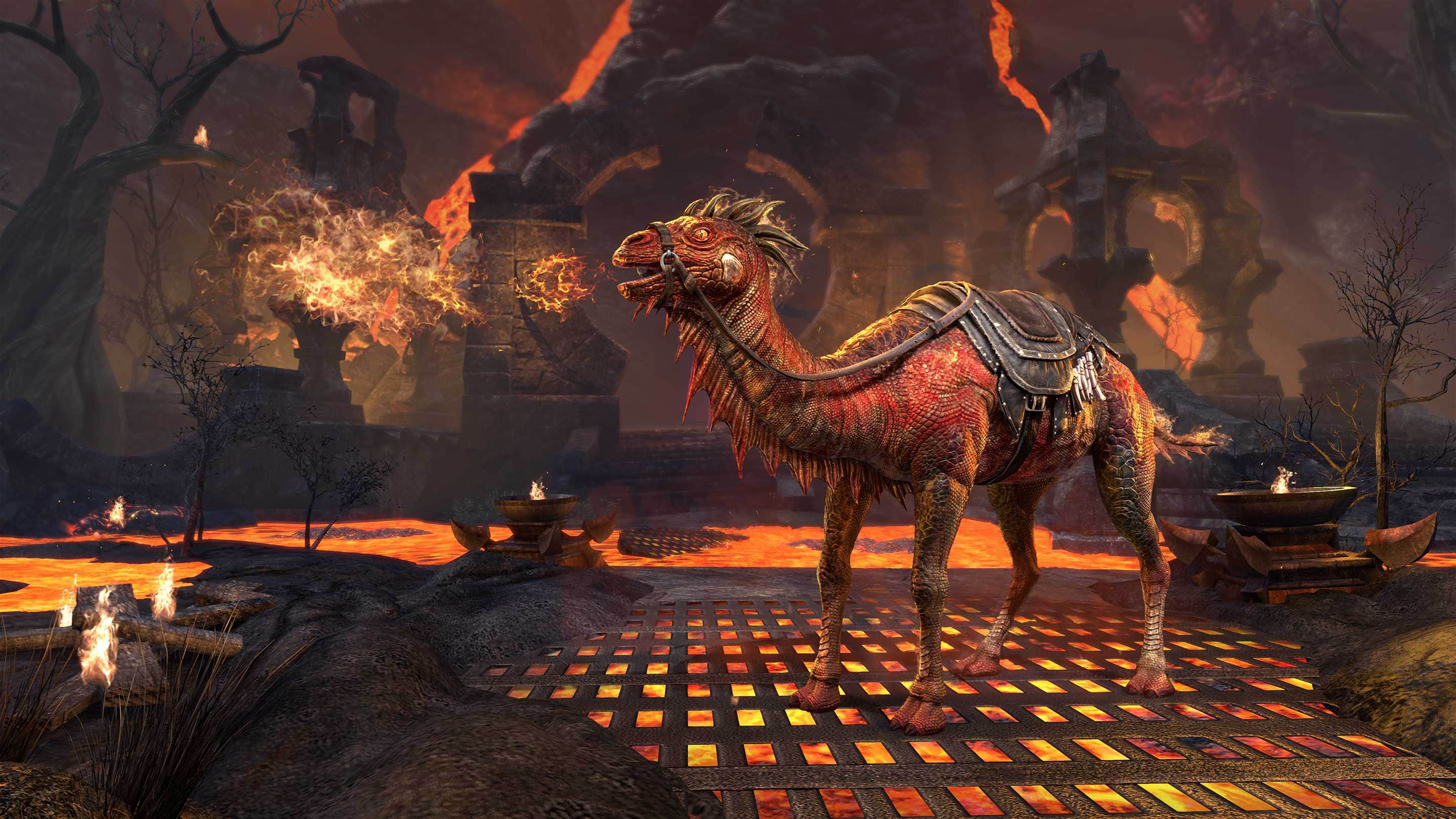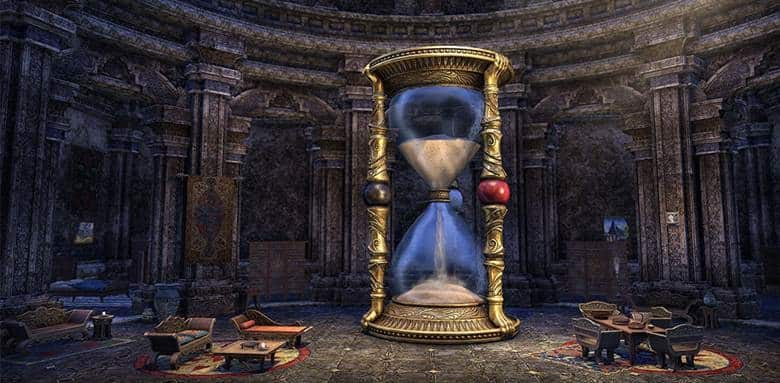
Discover what goes into making all the things you can place in your home with this new Developer Deep Dive featuring members of ESO’s Systems team!
For our next Developer Deep Dive, we reached out to Senior Systems Designer Cullen Lee and Systems Designer Katrina Trotta to talk about how the team goes about adding furnishings to ESO’s robust Housing System.
Thank you both for taking the time to dive deep into furnishings! To get us started, what exactly is a furnishing item in ESO and how do players get them?
Cullen: A furnishing is an item you can place in your home using the Housing System. There are many different types of furnishings, and with each update we try to release a variety of items using many of the lovely models that the Art teams were already creating for the zone.
We also create unique furnishings, too, like music boxes or some of our Crown Store offerings, that are often relatively complex. A furnishing might have unique visuals or some kind of special effects on it, or it might have unique functionality like crafting stations or the Armory.
Katrina: Yeah, basically if it exists as a fixture in the game, we can make it a furnishing, and even if it doesn't exist as a fixture yet, we can request it.
When it comes to acquiring furnishings, players have many ways to get them in game. There's crafting, pickpocketing, looting, clickies, or the master writ and luxury vendors, just to name a few. We have our own special portion of the Crown Store that exists through the Housing Editor in addition to Crown Store bundles and limited-time offers. We have furnishings incorporated into the rewards for other systems like Achievements, Antiquities, or Tales of Tribute, as well.
Is it difficult to determine which items should be made into furnishings?
Cullen: Yeah! With all the beautiful things that our artists create, we have an embarrassment of riches, so one of our main responsibilities is identifying which furnishings to generate. We want to make sure that, given the things that we know players will really want, the selection we land on hits those top desires within the time we have for the update.
But even before that, we have to figure out what kind of broad themes we want to hit with the update, what number of objects we want to make, and from what sources. For example, when working with the Tales of Tribute team, we decided early on that we wanted to have a certain number of Tribute furnishings that you could earn via achievements and by playing Tribute, so we budgeted that into our schedule.
Furnishings can be decorative, functional, or both
Does the ESO community play a role in the selection or even the design and creation of new furnishings?
Cullen: They absolutely do! We have a big list of player-requested furnishings that we go back to periodically when we're looking for inspiration. And when we're picking out our new furnishings, we try to make sure that we're building off our learnings from the past in terms of what players were excited for and asked for in previous updates.
A good recent example of that is in the structural set that we've added as part of Update 35. It includes a transparent window that you can plug into doorways or more custom-built frames—it’s pretty flexible, and it provides a new tool for people who want to build a custom house from scratch and have windows that let you actually look outside. Items like that are a direct result of the feedback we get from the housing community.
Was that the case with the recently revealed Sacred Hourglass of Alkosh (a new item that allows you to change the time of day in your home)?
Cullen: Yeah! That's based on some tech that we've wanted to develop for a long time, but which was actually prototyped by one of our engineers, Jimmy, whom the community may know as Cardinal05.
We hired him after he had created a super in-depth housing mod, so he is someone who started out in the community as a huge housing fan and has been an invaluable resource to the team.
So, what is the process from start to finish for the creation of a furnishing item?
Katrina: Let’s use a music box as an example, since we build all of these from scratch. For a given update, we come up with several pitches for new music boxes, some of which get approved. Once we get the music box idea approved, we send references and descriptions of how we’d like it to look to the Concept Art team and inform the Audio team we’ve started.
Once concept is complete and approved (everything needs approval!) and sent out to the larger team, we’re always in awe of how they’ve brought our ideas to life. At that point, our Environment team sculpts it in 3D, and with that 3D model now in-hand, we as Housing Designers can set up all the data required to make it an item players can interact with. We’re not done at that stage, though, since it needs animation and, usually, visual effects and lighting as well, so we usually have to wait for those to come in from those teams before we can call this closer to done. The work that the Animation team does is applied directly to the 3D model, so there’s no need for us to interfere with it. The Visual Effects team needs the data that we’ve stood up for them to use as the backbone to apply their work to it as well.
We need our Editorial department to name it and describe it, and we also keep Audio looped in as well so Editorial and Audio are on the same page for the description of the melody. We get an icon for it from the Environment team and marketing art from the Media Art team. The most important part of this, the melody for the music box, usually comes in last, from the Audio team. Once QA looks over all portions of it, then we can call it done!
Custom-made furnishings take a village to craft
It sounds like it takes a village to create a new furnishing. How does the Systems team manage it all?
Katrina: Most of the work related to how it looks happens outside of our team, but the Housing Design team does a lot of work and research on planning what to pull in as furnishings for a given update. We generally do at least 50 new furnishings per update, which is a lot of data to manage. We survey themes for the area, play the content to get an idea of what players will encounter, and coordinate with teams like In-Game Cosmetics and Content Design so that everything fits right.
While Housing Designers can’t commit new pieces of art to our build, we make it work by being the ones to request the parts to be built, then build the data for the items themselves and the data around it that gets it to the player. We decide what furnishings to make, where the players get them from, and how to craft them if they’re crafted—all the while making sure the experience engages players.
How is the process different when you're creating a furnishing from a pre-existing asset made for a new zone?
Katrina: Working with one singular item whose geometry already exists needs its data hooked up, an icon created, and a player-facing name applied to it. We bypass the Concept and 3D Modeling request stages with these, so it’s a simpler process on an individual furnishing’s level. However, when we do these types of items, we do them in large groups, so it’s not a trivial process. We tend to go over carefully what we pick for what sourcing type, and get it approved before any data work begins.
Not every 3D asset in our game is immediately usable for housing. For performance reasons, some assets are "finished" only on the sides that are visible to the player. With housing, all sides are visible, and therefore sometimes extra work is needed on the asset to get it to a usable state.
At what point in the process do you introduce QA to the new item?
Katrina: QA is part of the process the whole way. They review it when the 3D asset is completed, when the data is set up, and again at the end once it’s obtainable in game. We try to notify them at as many stages of development as we can.
You can find furnishings from many different locations.
Given the flexibility of the Housing Editor, how challenging is a new furnishing item for the QA team to test?
Cullen: Generally speaking, QA already has a regular test plan that has a variety of different checks in it. They make sure that the previews work correctly, that the interacts work correctly, that everything sounds appropriate, et cetera. And then if something breaks unexpectedly, we add a check to that test plan so that we don't run into the problem again in the future. There's always a secondary check in our release candidate build before it goes out to players, too. The process definitely requires expertise, but this way we avoid having to overcome the same challenges from scratch every time.
The Housing System is very robust, and players like to utilize furnishings in all kinds of complex and creative ways. Is it possible to account for all the different ways our players can use furnishings?
Cullen: We definitely try to think about how people are going to use a new item, and we always try to think a little bit outside the box. We're still consistently surprised by some of the creative stuff the players come up with, which is awesome.
I just saw a build where they decorated a plot with tiny miniature versions of houses that were made from things like jewelry boxes with parts of books clipped through to make tiny doors. Some lovely, totally off-the-wall usage I’ve never seen before with some of our more standard furnishings, and that's not something that we would have predicted.
When we're creating furnishings, we always try to make sure that they're as flexible as we can make them. In Update 35 for example, we added a new kind of nice tile floor with a bottom that looks like rafters in a ceiling. That way if you're building a house with it, you naturally get ceilings below and floors above. Or you can turn it on its side and use it to make little cubby holes to hold paintings.
We love when people are creative with furnishings, and we want to support it wherever we can.
Katrina: Yeah, I think platforms are some of my favorite things to do, especially if the top is not the same as the bottom. I love seeing players use platforms in unusual ways. It’s great seeing people log in to get at the new furnishings, because they use things in ways that I never thought possible. The creative brain is fantastic, and it can't be predicted.
Even the most basic items can be used in unexpected ways
Do you have any shout outs to the ESO Housing community that you’d like to make?
Cullen: I don't want to single any individual out because I don't want to forget anyone, but the people who post their homes on Reddit and the forums, and whose who share them in various housing guilds’ contests and with friends are what makes this community thrive. They show off what is possible and are a huge part of why housing is as fun as it is. The system would not be nearly as cool without y’all doing these amazing things.
Katrina: We also really appreciate the YouTubers and streamers. It’s really nice to get immediate feedback on an item. We often pull up a stream or look at a video someone recorded in the first week of PTS and see immediate feedback on what they liked and what they didn't like, and that can be a tremendous morale boost. And of course, seeing our players care a lot about what we care a lot about can help us make better decisions in the future, or get fixes in sooner rather than later.
A big thank you to both Katrina and Cullen for taking the time to dive deep into the Housing Systems’ furnishings. With more and more items being added to the pool each update, we love seeing how the community uses them to create ever-more incredible builds, so keep them coming! If you enjoyed this deep dive, tell us which furnishing you make the most creative use out of when working on your homes via Twitter, Instagram, and Facebook!




